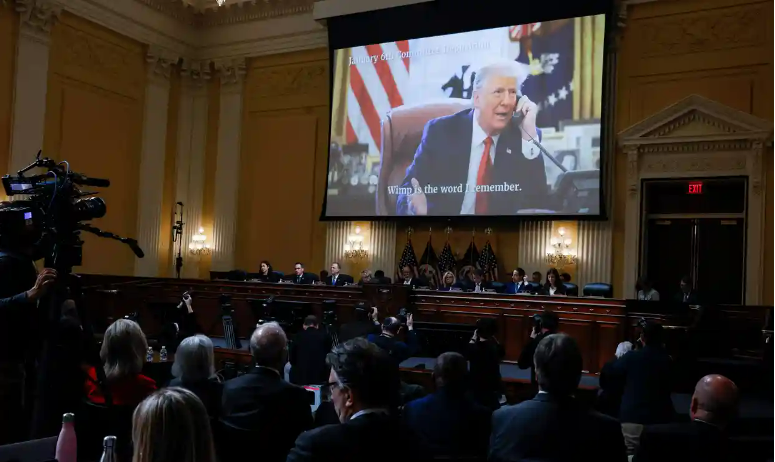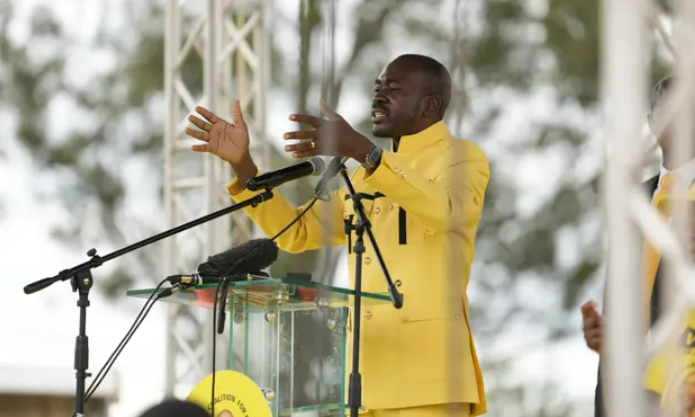The January 6 panel’s final report accuses Trump of a “multi-part conspiracy.”

In its final report, the congressional panel looking into the attack on the US Capitol on January 6 accuses Donald Trump of being part of a “multi-part conspiracy” to obstruct popular will and undermine democracy.
The 845-page report, which is broken up into eight parts and contains findings, transcripts of interviews, and legislative suggestions, is one of the most devastating official depictions of a president in American history.
Its release follows media allegations that it is cooperating and sharing vital material with the justice department, just three days after the select committee recommended that Trump be charged with a crime.
Since its formation in July of last year, the panel has conducted more than 1,000 interviews, held 10 public hearings, some of which were televised in prime time, and gathered more than a million documents. The panel will disband on January 3 when Republicans take control of the House of Representatives.
In its report, the panel gives a thorough and extensive account of Trump’s attempts to reverse Joe Biden’s victory in the 2020 presidential election, as well as what the panel believes to be his responsibility for a violent uprising by his fans.
It argues that despite knowing he had lost, Trump still pushed state officials and Vice President Mike Pence to annul the results. He was also “directly responsible for summoning what became a violent mob” and disobeyed repeated requests from his aides to denounce the rioters or urge them to disperse.
The executive summary of the document states that “the major cause of January 6th was one individual, former President Donald Trump, who many others followed.” “Without him, none of the January 6th events would have occurred.”
According to the committee, Trump or members of his inner circle engaged in at least 200 apparent acts of public or private outreach, pressure, or criticism directed at state legislators or state or local election supervisors in the two months between the election and the uprising. This included 125 social media posts by Trump or top advisers, at least 68 meetings, phone calls, or text messages, and 18 instances of notable public remarks.
The story intensifies political pressure already being applied to Merrick Garland, the attorney general, and Jack Smith, the special counsel looking into the uprising and Trump’s behavior.
According to the Punchbowl News website, the committee has started “extensively collaborating” with the special counsel by sending papers and transcripts, including texts received by Mark Meadows, the former chief of staff for the White House.
In its final open meeting on Monday, the panel unanimously decided to submit four cases to the justice department against Trump for his part in the uprising that began with his erroneous allegations of a stolen election and culminated in the mob siege of the US Capitol. Congress had never before used such force against a previous president in American history.
The committee’s unanimous adoption of the report included a recommendation that the House Republican leader, Kevin McCarthy, and other House members be the subject of congressional ethics inquiries into their refusal to comply with congressional subpoenas for information regarding their interactions with Trump before, during, and after the brutal assault.
The study claims that the participants “should be interrogated in a public forum regarding their advance knowledge of and role in President Trump’s intention to impede the peaceful transition of power.”
A criminal referral, although largely symbolic—the justice department will ultimately decide whether to charge Trump or others—was still a setback for the former president’s already sputtering 2024 reelection bid.
The panel was established in the summer of 2021 after Senate Republicans prevented the creation of a commission that would have been bipartisan and independent to look into the uprising. After that failed, the Democratic-controlled House established its own investigating committee, consisting of seven Democrats and two Republicans: Adam Kinzinger of Illinois and Liz Cheney of Wyoming.
The panel presented evidence over the course of an 18-month investigation that the attack on the US Capitol on January 6 was not a spontaneous protest but rather a planned “plot” by Trump to undermine democracy and rig the election.
On January 6, he invited followers to attend a “huge rally” in Washington. In a speech given in front of the White House, he energized his followers. He sent the crowd to the Capitol, knowing that some of them were armed, and told them to “fight like hell” for his presidency as Congress counted the votes. On Capitol Hill, he made an effort to follow them.
In the meantime, Trump encouraged proposals from right-wing attorney John Eastman to assemble alternative lists of electors, switching certain states that supported Biden to Trump, and presenting them to Congress for the vote count. The committee may also refer a criminal case against Eastman to the judicial department.
A large number of Trump’s ex-aides spoke in court about his unprecedented pressure on states, federal agents, and Mike Pence to protest the victory of Biden. The committee also discussed how Trump enraged the crowd at a rally that day and then did little to dissuade his followers for several hours as he watched the violence take place on television.
The committee reports that after they were inside the structure, Trump showed no concern when they yelled “Hang Mike Pence!” and he stubbornly refused for hours to heed the advice of his advisers to order the rioters to disperse. The story claims that President Trump’s emotions toward those who assaulted the Capitol were clear from the tweet’s concluding lines, “Remember this day forever!”
Regarding the incident, more than 800 persons have been charged. Stewart Rhodes, the founder of Oath Keepers, and four other people were found guilty of obstruction last month. Rhodes, who was also found guilty of seditious conspiracy, was accused of organizing a violent scheme to thwart the peaceful transfer of power despite the fact that he did not enter the Capitol.
Bennie Thompson, the meeting’s chairman, said: “The committee is drawing to a close, but as a nation we remain in weird and unexplored waters. This is still a period of reflection and reckoning over two years later.
We are very certain that this committee’s efforts will contribute to creating a path to justice, he continued.
Every American president, “save one,” according to Cheney, the committee’s vice chairwoman, has supported the peaceful transfer of power.
Trump stayed stubborn after that meeting. He claimed in a statement that “these people don’t understand that when they come after me, those who love freedom unite around me.” It gives me more vigor. When something doesn’t kill me, it makes me stronger.
The report makes recommendations for legislative changes, including suggestions for modernizing the Electoral Count Act of the 19th century, which was put under strain by Trump’s attempt to contest how Congress counts the votes.
After the release of the final report, Trump referred to it as a “witch hunt” and “very biased” in remarks made on his Truth Social network. It didn’t “examine the [January 6] protest’s cause, electoral fraud,” he claimed. Trump erroneously claimed the report left out his directive to his followers to demonstrate “peacefully and patriotically” on January 6.
Trump’s inaction when his supporters were forcefully storming the building is detailed in the committee’s report. He questioned a staff member whether they had seen his remarks on television as he entered the White House after his vehement speech.
The staff member reportedly remarked, “Sir, they cut it off because they’re rioting down at the Capitol.”
At 1:21 PM, after hearing about the riot from the employee, a White House photographer took a picture of Trump. The study claims that by then, if not earlier, “he had been made aware of the violent riot at the Capitol.”
The president’s daughter and key adviser Ivanka Trump made attempts to persuade him to order the demonstrators to disperse quietly on January 6th, according to the story.
According to reports, [chief of staff Mark] Meadows would phone Ivanka Trump every time she “felt she had made success” with her father, “to suggest the [P]resident still needed more persuading” — a pattern that continued for “many hours” that day.
According to the story, Trump and his attorney, former New York mayor Rudy Giuliani, persisted in attempting to postpone the joint session of Congress that would confirm Biden’s victory even after Trump recorded a video message urging the protesters to disperse.
Women’s right to education is being restricted by the Taliban. We can’t afford for the world to be silent.
Giuliani attempted to contact several members of Congress after speaking with Trump, including Senators Ted Cruz, Josh Hawley, and Lindsey Graham.
According to the committee, Giuliani accidentally left a voicemail for Senator Tuberville on Senator Lee’s phone, in which he recorded his request, so now we can say with certainty what he was up to. Regarding the electoral count, he wished for “you, our Republican friends, to try to merely slow things down” and postpone the joint session.
Between the time Trump completed his speech at the Ellipse and his initial attempt to calm the protesters, which included a final video message in which he begged his fans to leave while also assuring them that they were “very special,” 187 minutes passed.
Numerous employees and colleagues begged him to make a strong statement during those hours. He didn’t, though.
The committee cites those of Trump’s staunchest backers who accuse him of being responsible for the violence.
After the incident, longtime aide Hope Hicks texted Julie Radford, who had been Ivanka Trump’s chief of staff: “We all look like domestic terrorists now.”
I’m very outraged, Hicks texted a White House attorney. Everything we achieved was lost.
By all accounts, the president did not express sorrow or regret for what occurred at the Capitol. He didn’t seem to understand the significance of what he had started, either.
Trump spoke with Johnny McEntee, his director of people, on his final call of the evening.
He was informed by the president that “this is a crazy day.” The tone he used, according to McEntee, was “[l]ike, wow, can you believe this shit…?”
Did he show sorrow at the brutality that the Capitol had to endure? No, McEntee answered. “I don’t remember grief especially, but I believe he was stunned by, you know, it becoming a bit out of control.”





